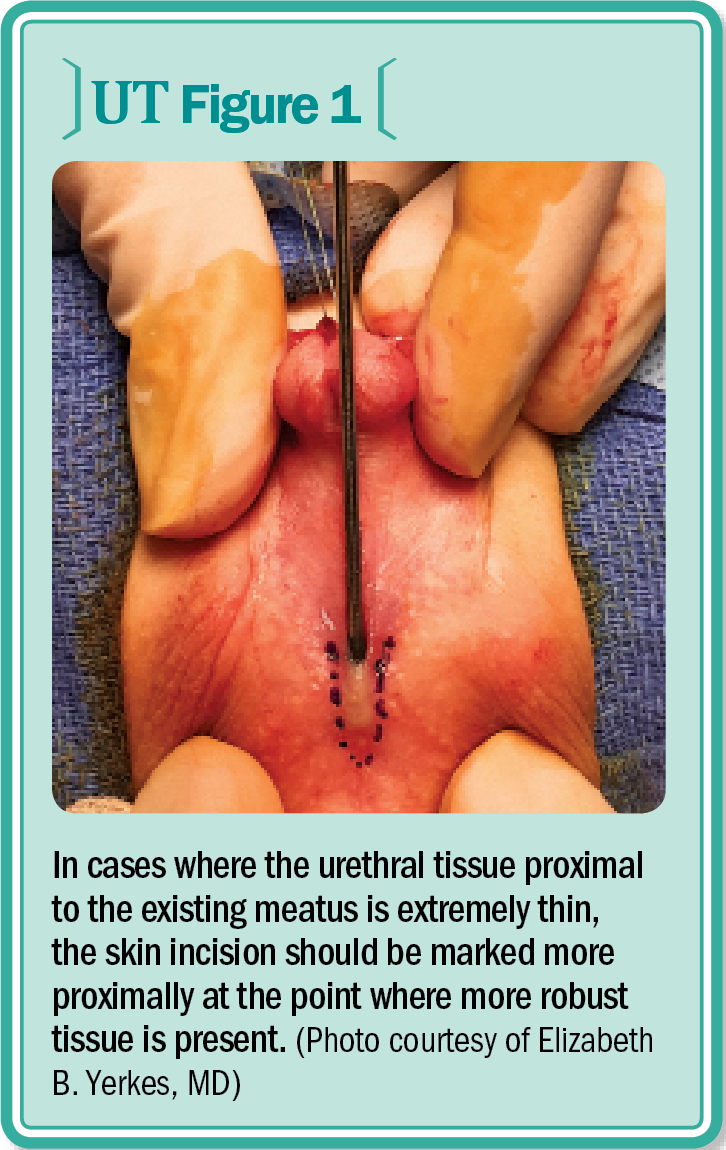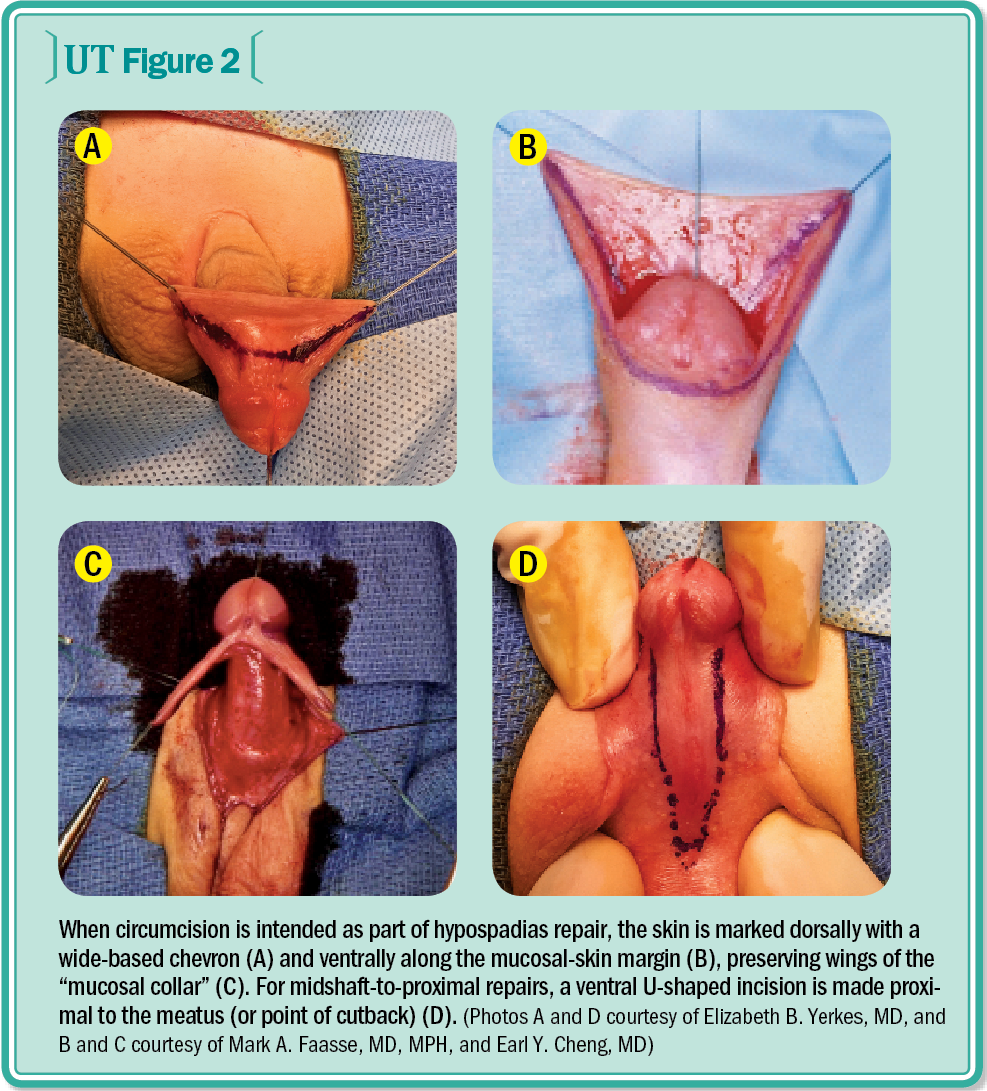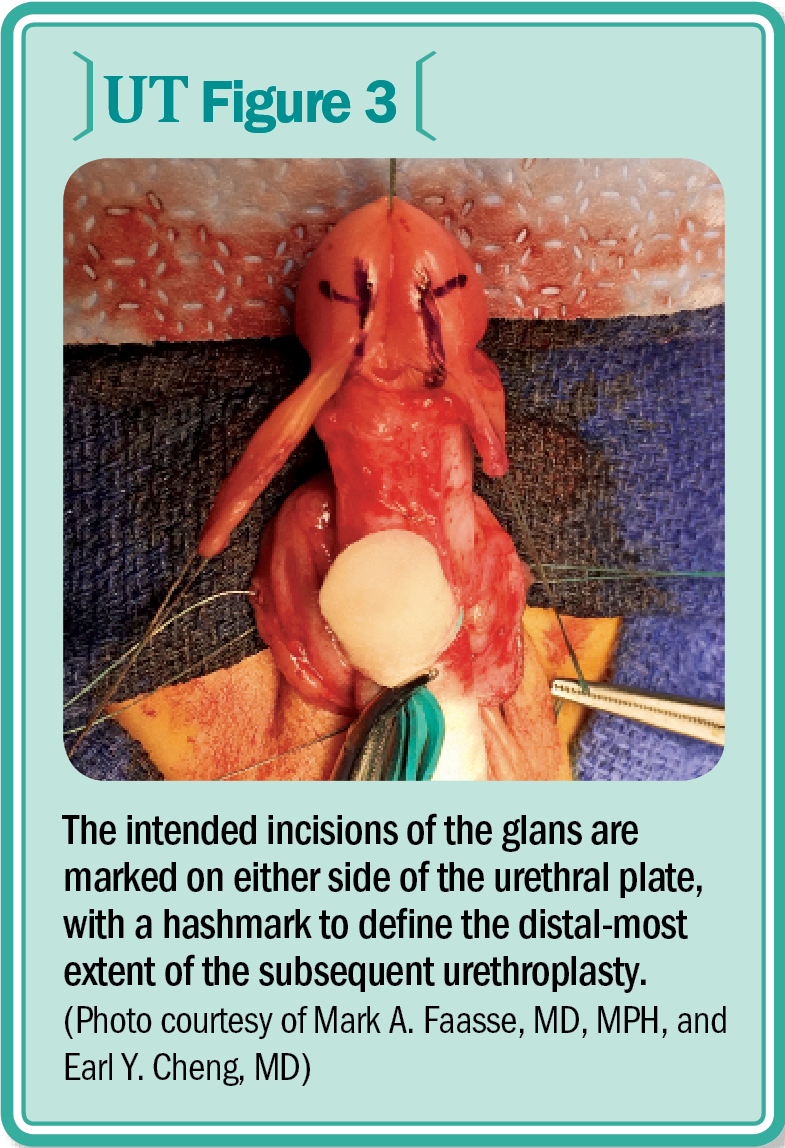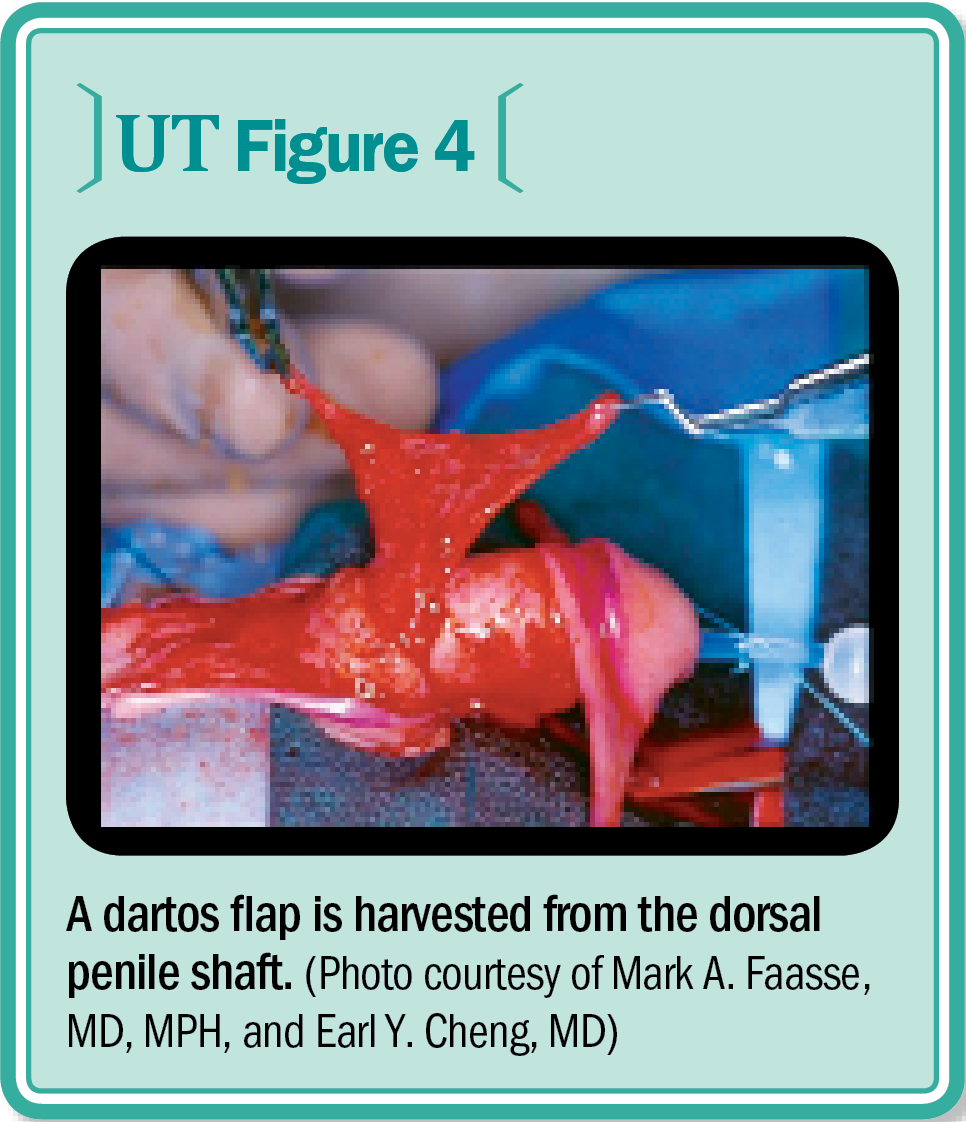Article
Pediatric hypospadias repair in 2015
Author(s):
This article provides a contemporary perspective on several aspects of hypospadias surgery, including preoperative counseling, use of androgen stimulation, and technical nuances for repair of routine midshaft-to-distal hypospadias, as well as more complex cases.


Hypospadias affects between 1 in 125 and 1 in 300 males, resulting from premature arrest of urethral fold tubularization. Some evidence suggests that the number of hypospadias cases is rising, with potential reasons including in utero exposure to endocrine-disrupting chemicals, higher maternal age, and improved survival of infants with associated syndromes (J Urol 2012; 188:2362-6). However, this trend remains controversial and may simply reflect greater awareness and reporting of milder forms (European Urology Supplements 2012; 11:33-45).
Read: Managing bone health in men with metastatic prostate cancer
This article provides a contemporary perspective on several aspects of hypospadias surgery, including preoperative counseling, use of androgen stimulation, and technical nuances for repair of routine midshaft-to-distal hypospadias, as well as more complex cases. A brief discussion of surgical outcomes and directions for future research is also included.
Parental counseling and timing of surgical repair
Patients with hypospadias usually present for evaluation as asymptomatic infants, and parents must decide whether to pursue surgery. Considerations include a desire to optimize future urinary function (i.e., being able to stand to void with a straight, directable stream) while preventing sexual dysfunction related to penile curvature, infertility related to inability to deposit semen in the vaginal fornix, cosmetic dissatisfaction, and psychosocial/sexual embarassment.
The natural history of untreated hypospadias is poorly defined. However, the severity of impact on urinary and sexual function is likely to correlate with the location of the urethral meatus and the degree of ventral curvature. Limited survey data suggest that adults with coronal or glanular hypospadias are generally satisfied with penile appearance and have little or no clinically significant differences in urinary or sexual function compared to normal controls (Urology 2008; 71:682-5; J Pediatr Urol 2014; 10:672-9). In these cases, foregoing surgery or opting for meatoplasty, correction of ventral curvature, and/or circumcision versus foreskin reconstruction alone may be suitable, with lower risk of complications than complete hypospadias repair.
We generally perform primary hypospadias repair between 6 and 12 months of age. We defer repair at younger ages because of potentially higher risks related to anesthetic exposure and our desire to allow the penis to grow larger during the “mini-puberty” that occurs within the first 6 months of life.
NEXT: Preoperative androgen stimulation
You might also like:
PTNS for overactive bladder: Patient selection and technique
Oncofertility: Current practice and vision for the future
How to manage testicular/groin pain: Medical and surgical ladder
Preoperative androgen stimulation
Prescription of testosterone (intramuscular or topical) or dihydrotestosterone (topical) within 1-3 months prior to surgery remains common to increase penile size and improve tissue characteristics; dosing regimens vary widely (J Pediatr Urol 2014; 10:672-9). This practice has become controversial in recent years, as some studies suggest that androgen stimulation may actually impair wound healing and be associated with higher risk of postoperative complications. However, all human clinical data to this effect have come from retrospective studies and are therefore vulnerable to selection bias and confounding factors, such as the severity of hypospadias and degree of ventral curvature. To date, the only randomized, controlled trial of preoperative androgen stimulation found topical dihydrotestosterone to have a significantly favorable impact on postoperative outcomes (J Urol 2008; 179:684-8). Unfortunately, dihydrotestosterone is not readily available in the United States.
Recommended: Use of robotics in pediatric urology
Additional randomized, controlled trials in this area are clearly necessary. We now use preoperative androgen stimulation selectively in cases where the glans is small and/or severe ventral curvature is present, when deficiency of skin for ventral coverage is of greater concern and need for vascularized skin flaps is more likely.
Repair of midshaft-to-distal hypospadias: TIP urethroplasty
Hundreds of papers have been published on surgical techniques and modifications for hypospadias repair. Today, most mid-to-distal hypospadias defects are addressed by tubularized incised plate (TIP) urethroplasty. Meatal advancement and glansplasty (MAGPI) remains applicable to glanular hypospadias, and some surgeons continue to use perimeatal-based flaps for urethroplasty (“flip-flap repair”). However, it is generally acknowledged that TIP repair achieves better cosmesis in terms of a vertically oriented, slit-like urethral meatus.
NEXT: Surgical aims of TIP repair
Detailed descriptions of TIP repair have previously been published with excellent illustrations (J Urol 1994; 151:464-5; BJU Int 2005; 95:683). Our objective is to supplement rather than replicate the content of these articles. From the outset, it is helpful to keep in mind the over-arching surgical aims:
- correction of ventral curvature (orthoplasty);
- repositioning the urethral meatus as close as possible to the tip of the glans penis (urethroplasty);
- constructing a conical glans (glansplasty); and
- skin coverage of the penile shaft.
Key principles include maintaining vascular supply to all tissue and achieving tension-free, non-overlapping suture lines. Use of loupe magnification or an operating microscope is standard.
Also see: Medical expulsive therapy ineffective for ureteral stones
The importance of properly planning the initial skin incisions cannot be overstated. After placing a glans retraction suture, we pass an 8F bougie à boule to gauge the quality of urethral tissue proximal to the existing meatus. In some cases, this tissue is nearly see-through, and the skin incision should be marked more proximally at the point where the tissue is no longer paper thin, allowing for cutback of the urethra to this point (figure 1).

Regardless of whether foreskin reconstruction (J Urol 2001; 165:1255-7) or circumcision is intended, marking the remainder of the initial incision is made easier by placement of holding sutures through the distal-most aspect of the prepuce on either side of the ventral deficiency. An adequate amount of “mucosal collar” is preserved for circumcision by marking the dorsal skin incision with a wide-based chevron (figure 2A). Ventrally, the incision follows the mucosal-skin margin (figure 2B). This results in “wings” of extra mucosal tissue on each side (figure 2C). If the urethral meatus is proximal to the corona or a cutback is planned, the initial incision must be carried proximal to the meatus (or point of cutback) in a U-shape, ideally maintaining at least a 10-mm width for the urethral plate (figure 2D).
NEXT: Incising and degloving the penis
While incising and degloving the penis, care must be taken to avoid inadvertent urethrotomy, as there may be little or no tissue between the skin and urethra because of divergent spongiosum. Dissection can be aided by placing a catheter in the urethra and, most important, putting the overlying skin on sufficient traction. We use stay sutures for this purpose. Initial dissection must remain as superficial as possible under the skin until the desired plane is established.

Degloving the penis usually provides adequate correction of ventral curvature associated with distal hypospadias. For mid-shaft or more proximal defects, an artificial erection may be performed with application of a tourniquet and instillation of injectable saline into the corpora cavernosa. Residual curvature can be addressed by dorsal plication at the point of maximal curvature. Plication sutures are placed in the midline to avoid injury of the neurovascular complex on the dorsolateral surface of the penile shaft.
Overly aggressive plication may result in kinking of the dorsal arterial blood supply to the glans penis. Therefore, glans perfusion should be reassessed later in the case after glans wing mobilization. On occasion, the plication suture needs to be removed or placed less aggressively to preserve glanular perfusion.
Once the penis is straight, attention is turned to preparation of the urethroplasty. For hemostasis, a tourniquet may be applied or the glans can be injected with lidocaine/epinephrine along either side of the urethral plate. We mark the intended incisions of the glans on either side of the urethral plate with a hashmark to define our intention for the distal-most extent of the subsequent urethroplasty (figure 3). Note that the glans incision proceeds slightly beyond this point.
Read: Here's who topped Twitter at AUA 2015
TIP derives its name from midline incision of the urethral plate, which facilitates tension-free tubularization of the plate margins. This incision should not extend distal to the urethral plate. Some surgeons prefer to incise the plate prior to making the glans incisions, so that the laterality of the glans incisions can be adjusted if the midline incision provides less laxity than anticipated. However, our experience has been that sufficient relaxation of the urethral plate can be obtained regardless of the width of the urethral plate simply by incising it deeply. The glans wings must be adequately mobilized by dissecting down to the tips of the corporal bodies and then slightly lateral and distal.
NEXT: Tubularization of the urethra
Tubularization of the neourethra can be performed around a 6-8F stent, using continuous or interrupted 6-0 or 7-0 absorbable sutures, such as polyglactin or polydioxanone. Subepithelial suture placement inverts the epithelial edges. Coverage of the urethroplasty is generally obtained by harvesting a dartos flap from the dorsal penile shaft (figure 4). Immediately prior to this, we may also elevate divergent spongiosal tissue from the corporal bodies to cover the neourethra (J Urol 2001; 163:1536-9). Tension-free midline approximation of the previously mobilized glans wings is then performed.

Following glansplasty, the final step of repair is tailoring of the penile skin for coverage of the shaft. It may be necessary to create Byar’s flaps by incising excess dorsal skin in the midline and wrapping the resulting skin flaps around to the ventrum of the penis. We apply a gentle compression dressing for 2-4 days to ensure hemostasis and reduce edema.
NEXT - TIP urethroplasty: Postoperative care
TIP urethroplasty: Postoperative care
We routinely leave the urethral stent in place for 5 to 10 days after TIP repairs. It remains unclear whether this practice decreases urethroplasty complications. However, it eliminates the possibility of acute urinary retention and potential need for postoperative catheterization through the newly constructed urethra.

Another controversial practice is use of prophylactic antibiotics for the duration of urethral stenting. We have initiated a multicenter, placebo-controlled trial to investigate the impact of prophylaxis on both infectious and wound-healing complications.
NEXT: Proximal and reoperative hypospadias repair
Proximal and reoperative hypospadias repair
Proximal and complex reoperative hypospadias repairs continue to be a challenging aspect of pediatric urology. In select cases, TIP urethroplasty can also be used for single-stage correction of proximal hypospadias, with limitations imposed by the degree of ventral curvature and quality of the urethral plate. When curvature exceeds 30° after degloving the penis, dorsal plication is suboptimal and transection of the urethra is advised, committing the patient to a staged repair.
Also see: Is focal therapy hope or hype? Urologists weigh in
After transecting the urethra, residual curvature can be addressed in one of two ways. The first option is corporal body grafting. This is performed by making a single full-thickness incision of the tunica albuginea from 3 to 9 o’clock on the ventrum of the penis, opposite the point of maximal curvature. The tunica is mobilized from underlying corporal tissue for a few millimeters in each direction, and a diamond-shaped piece of small intestinal submucosa (SIS) or tunica vaginalis is inserted into the resulting defect. Alternatively, several nearly full-thickness incisions (“fairy cuts”) can be made in the tunica albuginea without grafting.
There are also several options for bridging the defect between the proximal edge of the urethral plate and the glans penis. We prefer using a rotational, dartos-based flap of preputial tissue or Byar’s flaps; in most cases, the mucosal portion of prepuce proximal to the chevron incision portrayed in figure 2A will suffice. We also typically incise the midline of the urethral plate in the glans at the time of the first stage and incorporate the flap into this defect. Alternatively, a buccal graft may be used for the neourethra, as long as corporal body grafting was not performed. The remaining penile skin is then approximated to the lateral margins of the rotated flap or graft, and the neourethra is completed by tubularization during a second stage at least 6 months later.
When approaching reoperative hypospadias repairs, suitability of the native urethral plate for re-use must be carefully assessed. If any scarring is palpable more than 6 months after primary repair, we have a low threshold for excising the native plate and using buccal graft in a staged approach. Clinically significant residual penile curvature must be corrected prior to placement of the graft. Neourethral coverage with a well-vascularized tunica vaginalis flap should be considered when penile dartos has previously been harvested.
NEXT: Outcomes of hypospadias repair
Outcomes of hypospadias repair
Complication rates and cosmetic outcomes of mid-to-distal hypospadias repairs have improved considerably in recent decades. A recent population-based analysis suggests that only 5%-10% of these patients require reoperation (J Urol 2013; 190:251-6).
Unfortunately, reoperation rates for proximal repairs continue to be much higher, approaching or even exceeding 50% in some series. Long-term outcomes of modern surgical techniques are beginning to emerge, including patients’ self-assessment of urinary and sexual function and cosmesis as adults, but these data remain incomplete. Of particular concern to us are the durability and impact on erectile function of techniques currently being used for correction of ventral curvature, such as dorsal plication, fairy cuts, and corporal body grafting.
More from Urology Times:
Your most effective protection against a malpractice suit
Novel agent may protect against major UTI pathogen
Biomarkers yet to fully justify claimed clinical utility

Subscribe to Urology Times to get monthly news from the leading news source for urologists.
Newsletter
Stay current with the latest urology news and practice-changing insights — sign up now for the essential updates every urologist needs.

















